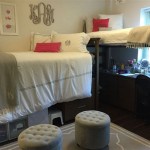Ideas To Decorate A Shared Room For Boy And Girl
Sharing a room presents unique decorating challenges, especially when the occupants are of different genders. Creating a space that caters to both a boy and a girl's individual tastes while maintaining a cohesive aesthetic requires careful planning and consideration. This article explores numerous decorating ideas to achieve a harmonious and functional shared room.
Establishing Separate Zones
One of the most effective strategies for decorating a shared room is to delineate distinct personal zones for each child. This allows for personalized expression within a shared space. This can be achieved through various methods including contrasting paint colors, strategically placed furniture, or the use of room dividers.
Color Coordination: While the room doesn't need to be completely uniform, a cohesive color scheme can unify the space despite individual zone variations. Selecting a neutral base color for the walls and then incorporating accent colors preferred by each child within their respective zones creates visual harmony.
Furniture Placement: Thoughtful furniture placement is crucial. Positioning beds on opposite sides of the room or separated by a bookshelf or dresser creates natural boundaries. Providing individual desks, dressers, and storage solutions helps maintain a sense of personal space and organization within each zone.
Room Dividers: Room dividers, such as curtains, folding screens, or open bookshelves, offer a more definitive separation, creating a sense of privacy. These can be particularly beneficial in smaller rooms or when children have significantly different sleep schedules.
Theme Integration
Although individual preferences should be acknowledged, selecting a unifying theme can tie the room together. This might involve a shared interest, such as nature, sports, or a favorite book series. Alternatively, abstract themes like geometric patterns or specific color combinations can provide a cohesive backdrop for individual expressions within each zone.
Shared Spaces: Designating a shared space within the room for activities both children enjoy fosters togetherness. This might involve a shared play area, a reading nook with comfortable seating, or a collaborative workspace for homework and creative projects.
Individualized Decor
While a unifying theme creates cohesiveness, it’s essential to allow for personalized decor within each child’s zone. This allows them to express their individuality and take ownership of their space.
Wall Decor: Allowing each child to choose artwork, posters, or wall decals for their designated wall area provides an opportunity for self-expression. This can include framed photos, personalized artwork, or decorative shelving to display their collections.
Bedding and Textiles: Bedding offers another significant opportunity for personalization. Allowing each child to select their bedding, including comforters, sheets, and throw pillows, allows them to create a personalized and cozy retreat within their zone.
Storage Solutions
Adequate storage is crucial in a shared room to maintain organization and prevent clutter. Incorporating individual storage solutions for each child helps them manage their belongings and maintain a sense of order.
Personalized Storage Bins: Providing labeled storage bins or baskets allows each child to store their belongings efficiently. This helps prevent belongings from mixing and reduces the potential for conflict over shared resources.
Under-Bed Storage: Utilizing under-bed storage containers maximizes space and provides a convenient location for storing out-of-season clothing, extra bedding, or other less frequently used items.
Wall-Mounted Shelves: Installing wall-mounted shelves or cubbies offers additional storage space without taking up valuable floor space. These can be used to display books, toys, or decorative items, adding a touch of personality to each zone.
Practical Considerations
Functionality is paramount in a shared room. Addressing practical concerns such as lighting and privacy ensures the space caters to the needs of both children.
Lighting: Incorporating a combination of ambient, task, and accent lighting ensures adequate illumination for different activities. Providing individual bedside lamps allows each child to control their lighting and creates a personalized atmosphere within their zone.
Privacy: Respecting each child's need for privacy is essential. In addition to room dividers, black-out curtains can enhance privacy and create a sense of seclusion within individual sleeping areas.
Flexibility and Adaptability
Children's tastes and needs evolve over time. Designing a room that can adapt to these changes is crucial for long-term functionality. Selecting furniture that can be repurposed or rearranged, and incorporating flexible storage solutions, allows the room to evolve alongside the children's growing needs and preferences.
Open Communication
Involving both children in the decorating process is essential. Open communication and collaboration ensure that the room reflects both their individual personalities and shared interests, fostering a sense of ownership and promoting a harmonious living environment.

Pin Em Quartos



30 Genius Shared Bedroom Ideas For Kids

Boy Girl Shared Bedroom Ideas Kids Activities Blog

Pin On Room Decor

24 Ideas For Designing Shared Kids Rooms Extra Space Storage

Tips Tricks For Shared Bedrooms Project Nursery

Shared Boy Girl Room Decor For Kids

Shared Bedroom Ideas For Kids Ohmeohmy Blog







